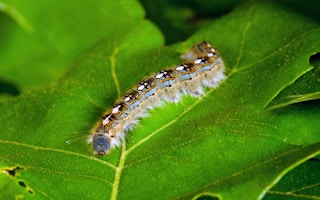Insects could be about to complicate things for climate scientists who want to model the carbon budget in a warming world.
As more carbon dioxide builds up in the atmosphere, the trees should respond, put on extra growth and soak up more carbon. But if herbivorous insects start to respond to a warmer world, this classic instance of what engineers call negative feedback could become a little more complicated.
Entomologists John Couture, and Richard Lindroth, and colleagues at the University of Wisconsin-Madison in the US, report in the journal Nature Plants on the results of a large-scale, extended outdoor experiment in which aspen and birch trees were subjected to heightened levels of carbon dioxide and ozone.
Although the trees had been planted in natural conditions, a network of pipes supplied the environment around them with levels of greenhouse gases predicted for 2060.
Extracted nutrition
The scientists collected leaf samples from the plantation canopy and detritus from the ground beneath the trees to begin a calculation of the production and loss of biomass every season. The cut leaves provided a clue to insect damage, and the insect excrement separately told a story of extracted nutrition.
“
This is the first time, at this scale, that insects have been shown to compromise the ability of forests to take up carbon dioxide.
Richard Lindroth, entomologist at the University of Wisconsin-Madison
They found that although the carbon dioxide did indeed fertilise the forests, the extra growth also stimulated insect attack. The levels of damage by very hungry caterpillars and other herbivores almost doubled. Every year, across ever square metre, insect pests and parasites consumed 70 grams of carbon-sequestering biomass.
They found that if accompanying ozone levels were higher – and low-level ozone in some places could increase in a warmer world – then the losses were significantly less. Ozone is also toxic to plants, so this may not be of long-term comfort either.
“This is the first time, at this scale, that insects have been shown to compromise the ability of forests to take up carbon dioxide,” Professor Lindroth says.
The key word here is scale. The study was conducted in the real world, rather than in a laboratory or a computer simulation.
But it was still limited to a selection of sample plots, so the question remains open as to whether, at the global level, plants will take up more carbon, or whether the insects eat up the difference and return it to the atmosphere?
Carbon cycle
Research such as this is a reminder that the world is a complicated place, and the details of the carbon cycle are likely to go on giving climate scientists a headache for years to come.
The extra fertilisation by carbon dioxide didn’t make the trees more nutritious, or more appetising: if anything, the reverse. Think of the difference between processed white bread and a high-density, nourishing loaf from a master baker.
“There’s a lot more protein in the bakery bread than in the white bread,” Dr Couture says. “Insects have a base level of nutrients they need in order to grow, and to reach that they can choose either to eat higher-nutrient food – unfortunately insects don’t always have that choice – or to eat more.”
And Professor Lindroth adds: “The big question is, will northern forests grow faster under elevated carbon dioxide? Carbon dioxide is a substrate for photosynthesis. It gets converted into sugars, which then become plant biomass. Will trees take up more carbon dioxide, and thus help reduce its increase in the atmosphere?”










